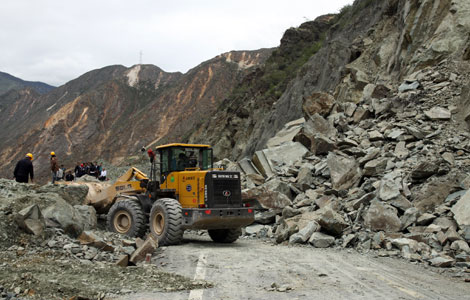Keeping open the lifeline to Tibet
Updated: 2013-10-28 07:38
By Hu Yongqi and Li Yingqing in Deqen, Yunnan (China Daily)
|
||||||||
|
New horizons in train for Shangri-La tourism |
|
Most locals seemed indifferent to a railway project currently under way to connect Shangri-La with the tourist paradise Lijiang city, which is equidistant between Kunming, the provincial capital, and Shangri-La and will link the two larger cities. However, those who have taken an interest in the 139-km-long line expect to see plenty of changes. The journey between Kunming and Shangri-La can take as long as 12 to 14 hours by bus, even in light traffic. Flying is an option, but few locals can afford it. That means the extension to the railway is likely to become the favored choice of travelers, for reasons of safety and cost. The new railway will cost 9.2 billion yuan ($1.5 billion). Half of the money was provided by the central and provincial governments and the other half was raised through bank loans. When the railway becomes operational, 11 trains will run every day and around 2.53 million metric tons of cargo will be transported between the two cities every year, reducing the burden on long-distance highway transport. According to the Chinese Academy of Geological Sciences, the railway will run through at least four geological fault lines in the transition zones of the Qinghai-Tibet plateau and the Yunnan-Guizhou plateau. The academy foresaw that progress could be hampered by rock falls and landslides, so the total construction time for the project was set at six years. The geological conditions are difficult. The railway begins at Lijiang, which sits at an altitude of more than 2,000 meters, descends to around 1,000 m when traversing the Jinsha River valley, before climbing once again to reach the prefecture's capital, Shangri-La, at 3,340 m. Sonam Jorden, 29, a driver for a hostel in Shangri-La, said the railway will bring many more visitors to his hometown and help business. "I will definitely take the train when the railway arrives at our town," he said. On Jan 1, 2010, a railway linking Dali Bai autonomous prefecture with Lijiang, a world heritage site, began operations. The 164-km-long link, which took six years to complete, has boosted tourism and the economic development of Lijiang, according to Kunming Railways Bureau. Yunnan is the Chinese starting point of the Pan-Asia railway network, which will have three lines: Central, East and West. A line is being built between Dali and Ruili city, in Dehong Dai and Jingpo autonomous prefecture, and Myanmar. Meanwhile, a line being built between Dali and Hekou in Honghe Hani autonomous prefecture, which borders Vietnam, will be completed soon. By 2015, the new Shangri-La-Lijiang line will be completed. It will reduce the total traveling time between Kunming and Shangri-La to roughly nine or 10 hours, according to Kunming Railways Bureau, and will allow tourists from across Southeast Asia to flock to the city named after the location of James Hilton's classic adventure novel, Lost Horizon. Hu Yongqi in Shangri-La, Yunnan province |

 Serena completes dominant season with triumph
Serena completes dominant season with triumph
 Nuclear submarine fleet comes of age
Nuclear submarine fleet comes of age
 5 pharmacies begin to sell baby formula
5 pharmacies begin to sell baby formula Mother and four children stabbed to death in New York
Mother and four children stabbed to death in New York
 China Fashion Week S/S 2014: day 2
China Fashion Week S/S 2014: day 2
 Demonstrators protest against govt surveillance in US
Demonstrators protest against govt surveillance in US
 Where art thou, my love?
Where art thou, my love?
 Li Na reaches WTA Championships final
Li Na reaches WTA Championships final
Most Viewed
Editor's Picks

|

|

|

|

|

|
Today's Top News
High speed versus history
Southern states gear up for symposium
Film finds a hip-hop-tai chi connection
Jewelry exhibit dazzles Southern California
Obama aware of spying on Merkel: German paper
Five stabbed to death in NYC
Forum urges stable China-Japan ties
NSA spying hurts US diplomacy
US Weekly

|

|






